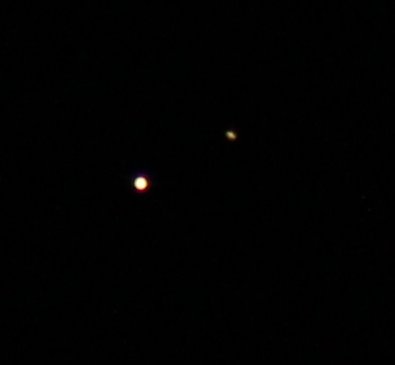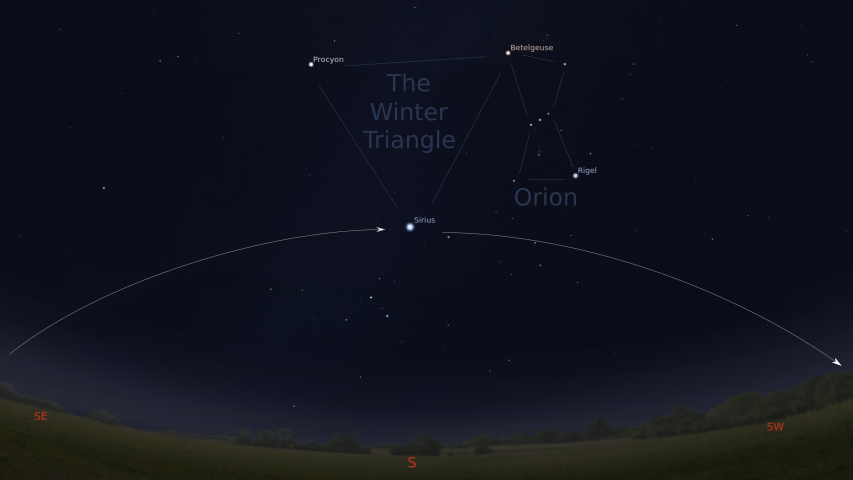The New Year's Eve Star, and the Quadrantids
December 29, 2020
Happy Holidays!
I hope you had a chance to observe the Great Conjunction where you live. The weather here in Iowa was cloudy right up until the day of closest approach, but then luckily cleared on the big day itself. After enjoying the sight for a few moments, I tried to obtain some photographs through my telescope, but the atmospheric conditions were awful. (The winds had been raging, and there was a little haze, so the “seeing” was lousy. The atmosphere itself caused blurriness in the telescopic photos.) I froze my fingers two evenings in a row, and wished I lived in Acapulco. This was the best picture I managed to obtain, and I took it not through my telescope, but through my camera's telephoto lens:

Even though the day of closest approach has passed, continue to keep your eyes on the sunsets. Jupiter and Saturn are now gradually separating, but the pair will continue to provide a lovely decoration over the sunsets for several more weeks to come.
Coming up in the following week, we have a star to ring in the New Year, and another meteor shower.
The New Year's Eve Star
One of the brightest patches of the night sky, containing one of the brightest and most recognizable constellations, is beginning to rise into the eastern skies in these evenings, as the sun sinks in the west. This bright patch follows the course of the sun, arcing across the southern skies, and by midnight it is standing up straight in the south.

Most observers will recognize Orion, with his distinctive belt, surrounded by a rectangle of bright stars. His right shoulder and left knee (assuming he is facing you) are two of the brightest stars in the sky—their names are Betelgeuse and Rigel. (“Betelgeuse” is a malformation of an Arabic name, and an authentic pronunciation would be something like “Bet-el-jooz”...but most people just call this star Beetlejuice.)
Two the east of Orion are two more very bright stars, including the brightest star in all the sky (if you don't count the sun, which I don't). The star to Orion's right (if he is facing you) is Procyon, and the star below him is Sirius, the “dog star” and the brightest star in the sky. Their respective constellations are Canis Minor and Canis Major—Orion's two canine hunting companions. Do you notice something about Betelgeuse, Procyon, and Sirius? They form an almost perfect equilateral triangle in the sky. This near-perfect triangle next to Orion, composed of three of the brightest stars in the sky, including the brightest of all, is a vivid and important marker in the winter skies. Important things need names, and the name for this triad is, astonishingly, the “Winter Triangle”.
By the way, if you make a list of the brightest stars in the sky, Sirius is #1, Rigel is #7, Procyon is #8, and Betelgeuse is #10. As I said, this grouping is one of the brightest landmarks in the sky.
And at midnight on New Year's Eve, this brilliant assembly stands upright in the south. At just this moment, Sirius reaches the peak of its arc. It stops rising in the eastern sky, crosses the southern meridian into the western sky, and begins its descent. Midnight on New Year's Eve is the exact moment when Sirius pauses at the top of its arc, in between the eastern and western halves of the sky, temporarily marking due South. We can call Sirius the “New Year's Eve Star”, because it passes from east to west, just as the year passes from old to new. The brightest star in the sky rings in the new year by tipping its hat, so to speak. (To be a little more formal: When a star stops ascending in the east, peaks in the south, and starts its descent in the west, astronomers and navigators call this a “culmination”, or a “transit” of the “meridian”. Sirius culminates at midnight on New Year's Eve.)
Incidentally, if you are a fan of the Harry Potter series of books, you may recognize the name Sirius. Several members of the fictional Black family draw their names from among the stars, and there are two in this map: Sirius, and Bellatrix, which is the name of Orion's other shoulder.
The Quadrantids
The first meteor shower of the new year has the potential to be impressive, but I hesitate to recommend it. Unlike other meteor showers, the January Quadrantids have a very narrow peak—only a few hours—so it is easy to miss, and depending on your time zone the best part of the show might occur entirely in the daytime. In addition, this year the Quadrantids will be drowned out by a nearly full moon.
Regarding rates, I find inconsistent reports: from a couple dozen to 50 or 100 per hour. Like most meteor showers, it probably varies a bit from year to year, and a lot with the quality of the night sky. On the plus side, the Quadrantids often include impressive bright fireballs.
So I would say that if you are a night owl with a strong desire to see fireballs, you should stay up for this one, but if you need your sleep, you can skip this one and likely not miss much.
To quote the American Meteor Society: “The Quadrantids have the potential to be the strongest shower of the year but usually fall short due to the short length of maximum activity (6 hours) and the poor weather experienced during early January. The average hourly rates one can expect under dark skies is 25. These meteors usually lack persistent trains but often produce bright fireballs.”
If you do want to watch for fireballs, the Quadrantid's peak is predicted to occur this year on the night of January 2-3. The radiant (the point among the constellations out of which all meteors appear to fly) is roughly halfway between the Big Dipper and Arcturus. If you follow the arc of the handle of the Big Dipper, you will “arc to Arcturus”, and roughly at the peak of this arc lies the radiant. (This part of space used to be named Quadrans Muralis, the “Mural Quadrant”, hence the name “Quadrantids”, but this constellation is no longer officially recognized.) In the middle of the night, this point will lie mid-way up in the northeast, so your best bet is to lie back with your feet pointed northeast, for an hour or more between midnight and dawn, and let your eyes roam over the highest parts of the sky.
Happy Viewing, and Happy New Year!